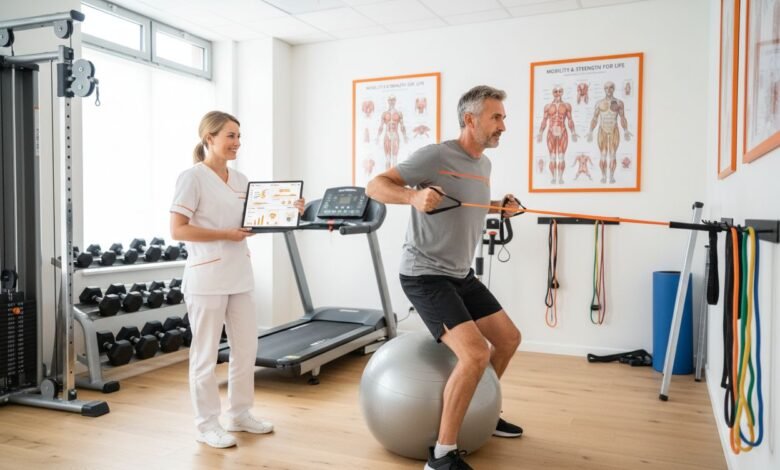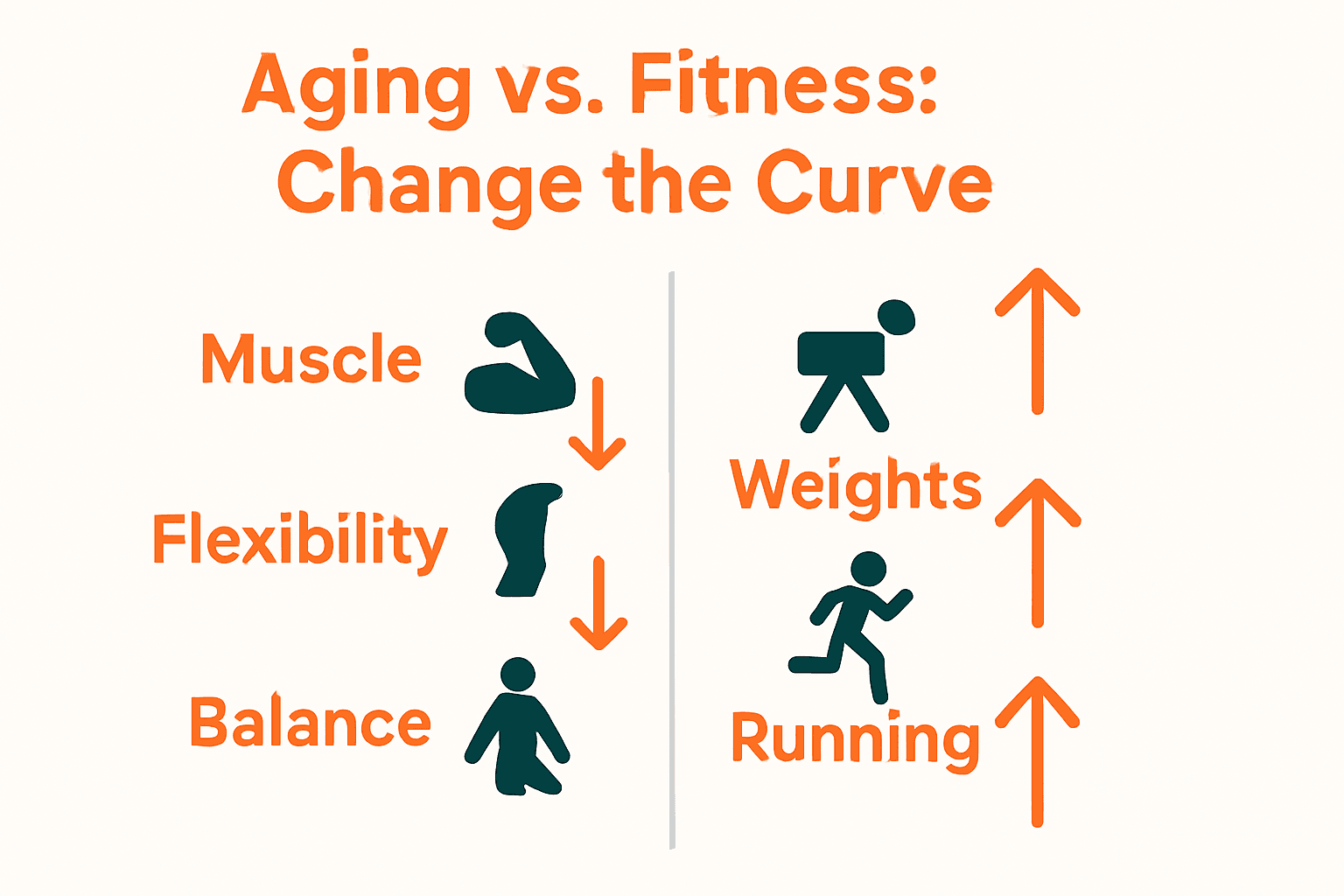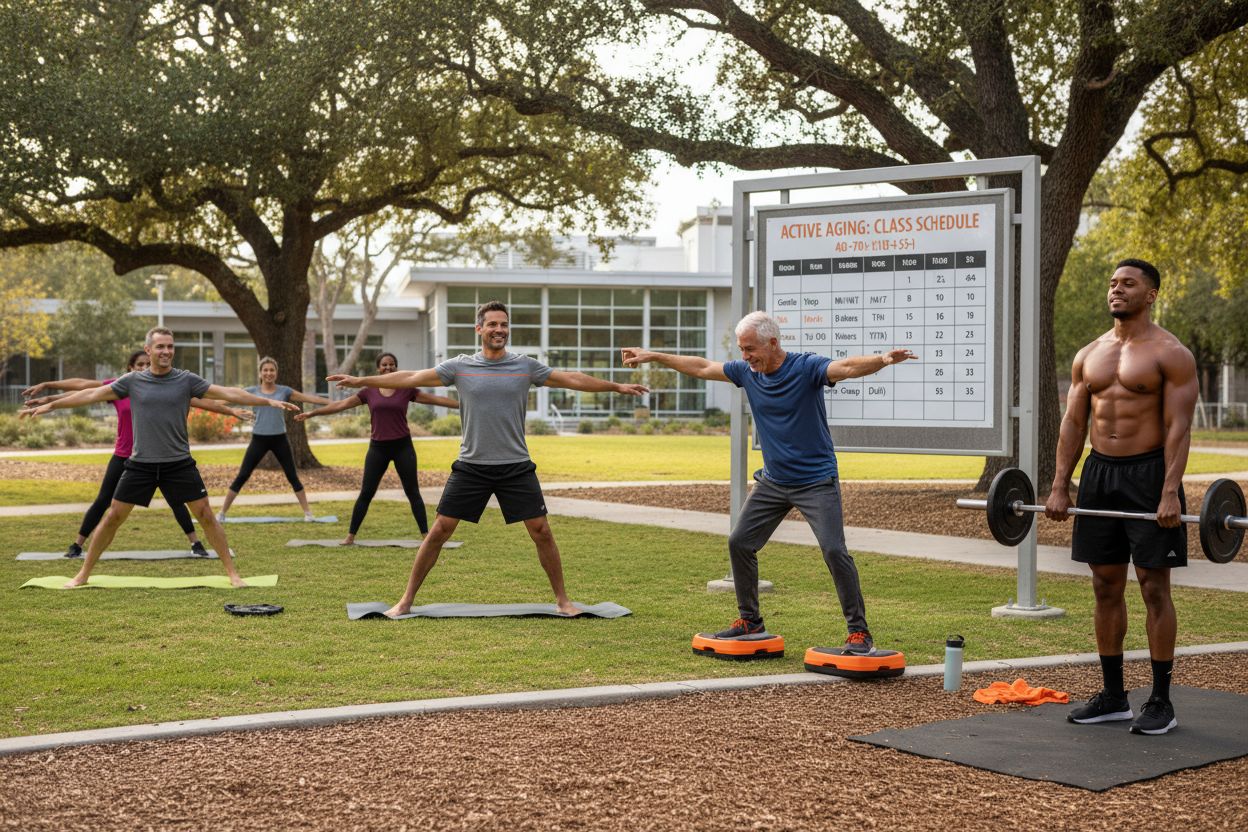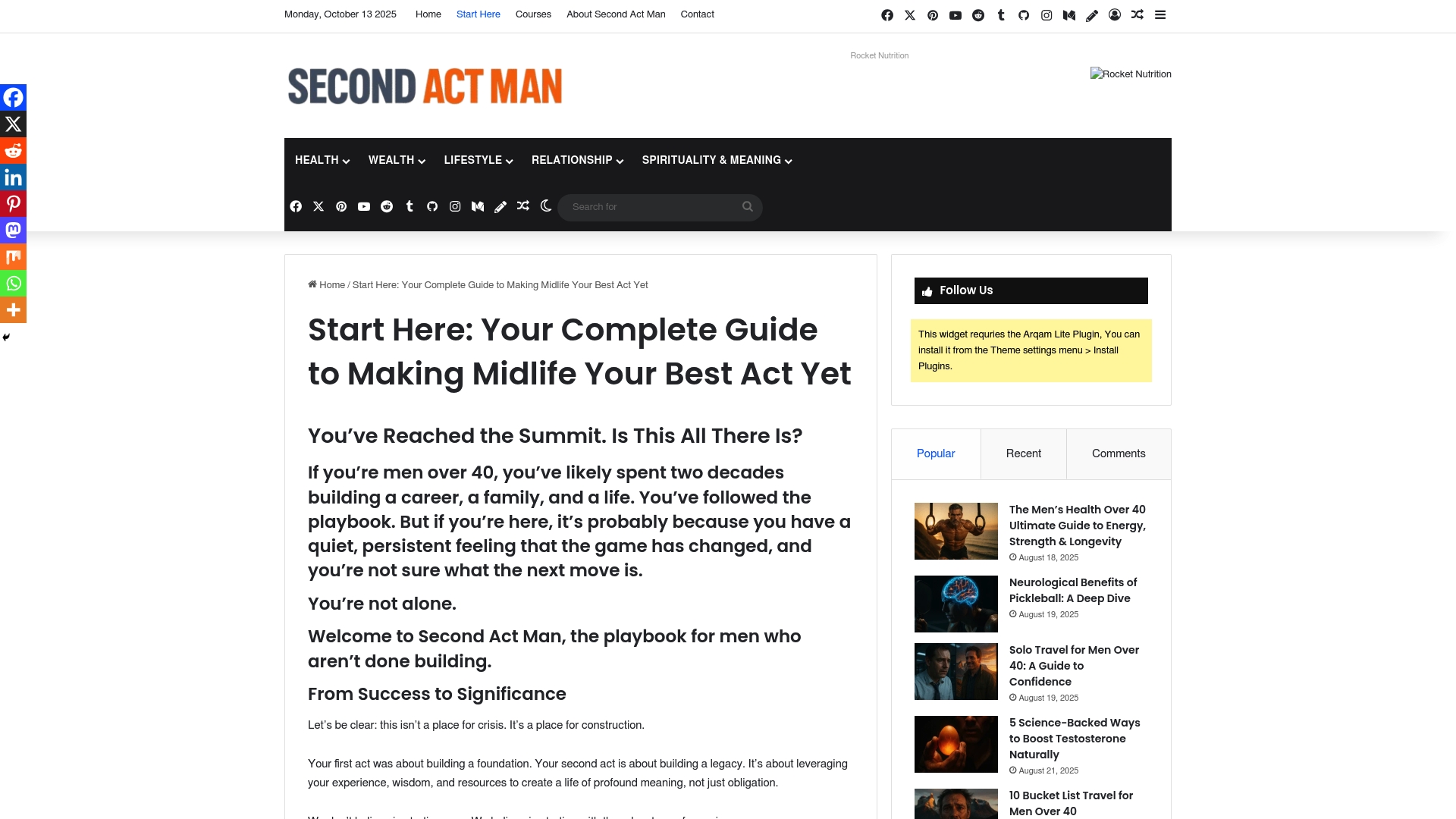Complete Guide to the Role of Fitness in Aging

Did you know that muscle loss can start as early as your mid-30s, but most men do not realize its impact until years later? As the years add up, preserving strength, flexibility, and energy becomes more critical for staying active and independent. Understanding fitness for men over 40 is about more than exercise routines. It’s about building lifelong resilience so you can live with strength, confidence, and freedom at every stage.
Key Takeaways
| Point | Details |
|---|---|
| Adopt Functional Fitness | Focus on functional fitness to maintain movement and independence as you age. It supports performance in everyday activities with strength and flexibility. |
| Incorporate Strategic Exercise Types | Men over 40 should engage in resistance training, cardiovascular, flexibility, and balance exercises to optimize health and prevent injuries. |
| Overcome Common Fitness Myths | Challenge misconceptions about aging and exercise; it’s never too late to start, and physical activity offers significant health benefits at any age. |
| Prioritize Medical Guidance | Consult medical professionals before starting new exercise routines to ensure safety and develop a tailored fitness strategy. |
Table of Contents
- Defining Fitness And Its Role In Aging
- Types Of Exercise Beneficial After 40
- Fitness Impact On Physical And Mental Health
- Common Fitness Myths About Aging
- Risks, Barriers, And Mistakes To Avoid
Defining Fitness and Its Role in Aging
Fitness isn’t just about looking good or lifting heavy weights – it’s about maintaining your body’s fundamental ability to move, perform, and thrive as you age. Functional fitness emerges as a critical concept for men navigating their second act, representing the physical capabilities that allow you to perform everyday activities with strength, flexibility, and confidence.
According to Harvard Health, age-related declines begin as early as the mid-30s, manifesting through muscle loss, reduced strength, and diminished aerobic capacity. But here’s the game-changing truth: these declines are not inevitable. Strategic fitness training can actively counteract these natural changes, helping you maintain:
- Muscle mass and strength
- Joint mobility and flexibility
- Balance and coordination
- Metabolic efficiency
- Overall functional independence
The World Health Organization provides clear guidance for men over 40, recommending at least 150 minutes of moderate-intensity aerobic activity weekly, complemented by muscle-strengthening exercises performed twice or more per week. Read more about men’s midlife health strategies to understand how fitness becomes your secret weapon against aging.
Ultimately, fitness in midlife isn’t about competing with twenty-somethings. It’s about building a resilient, capable body that supports your ambitions, maintains your independence, and allows you to fully engage in your personal and professional second act. Your fitness journey is less about performance and more about sustainable, functional strength that empowers your next chapter.
Types of Exercise Beneficial After 40
After 40, your fitness strategy needs to shift from pure performance to strategic, holistic training that supports overall health, prevents injury, and maintains functional strength. Not all exercises are created equal – and understanding the right mix can dramatically transform your physical capabilities during this pivotal life stage.
According to Michigan State University, strength training emerges as a cornerstone of midlife fitness, offering remarkable benefits when performed at least twice weekly. This approach doesn’t just build muscle – it provides comprehensive physiological advantages:
- Enhances muscle and bone strength
- Increases bone mineral density
- Reduces osteoporosis risk
- Improves insulin metabolism
- Boosts metabolic rate
A well-rounded fitness approach for men over 40 should incorporate four primary exercise types:

Here’s a summary of the primary exercise types and their benefits for men over 40:
| Exercise Type | Main Benefits | Example Activities |
|---|---|---|
| Resistance Training | Maintains muscle mass Strengthens bones | Weightlifting Push-ups |
| Cardiovascular | Improves heart health Boosts metabolism | Brisk walking Cycling |
| Flexibility Work | Enhances mobility Prevents stiffness | Yoga Stretching |
| Balance Training | Reduces fall risk Improves coordination | Tai chi Single-leg stands |
- Resistance Training: Weight lifting or bodyweight exercises that maintain muscle mass
- Cardiovascular Exercise: Low-impact activities like cycling, swimming, or brisk walking
- Flexibility Work: Yoga or stretching routines to maintain joint mobility
- Balance Training: Exercises that prevent falls and maintain coordination
Explore our comprehensive midlife reboot guide to understand how these exercise types can be strategically integrated into your lifestyle. Remember, fitness after 40 isn’t about looking like a bodybuilder – it’s about building a resilient, capable body that supports your ambitions and keeps you performing at your best.

Fitness Impact on Physical and Mental Health
Fitness isn’t just about maintaining a physique – it’s a comprehensive system of health optimization that touches every aspect of your physical and mental well-being. For men navigating their second act, understanding the profound interconnection between exercise and holistic health becomes a game-changing insight.
According to University of Utah Health, regular exercise delivers a remarkable spectrum of health benefits for older adults, dramatically reducing risks of:
- Osteoporosis
- Falls and hip fractures
- Heart disease
- Diabetes
- Stroke
- Depression
- Cognitive impairment
Moreover, brain health receives extraordinary benefits from consistent physical activity. Research from the University of Iowa reveals that moderate to vigorous aerobic exercise can actually increase hippocampal volume and improve functional brain connectivity, directly supporting cognitive function and executive performance.
Learn more about transforming your midlife health strategy and understand that fitness is your most powerful tool for maintaining independence, vitality, and mental sharpness. Your workouts are not just physical training – they’re an investment in a robust, resilient version of yourself that can tackle professional challenges, personal goals, and life’s unexpected turns with unwavering strength and clarity.
Common Fitness Myths About Aging
Men over 40 often hear a barrage of discouraging myths about fitness that can sabotage their health journey. These misconceptions create mental barriers that prevent many from taking control of their physical well-being during a critical life stage. Age limitations are more psychological than physiological – a mindset that needs urgent recalibration.
Harvard Health directly challenges the pervasive myth that exercise becomes ineffective with age. Their research reveals compelling evidence that regular physical activity can:
- Reduce heart attack risk
- Decrease stroke probability
- Lower cancer incidence
- Significantly increase life expectancy
According to Utah State Extension, another critical myth to demolish is the belief that it’s “too late” to start exercising. Their research conclusively shows that consistent physical activity initiated even in senior adulthood can dramatically improve:
- Overall physical health
- Mental well-being
- Cognitive capabilities
- Long-term longevity
Explore strategies for midlife health transformation and understand that your body is incredibly adaptive. The real limitation isn’t your age – it’s your willingness to challenge outdated narratives about aging and fitness. Your second act isn’t about slowing down – it’s about strategically leveling up your physical potential.
Risks, Barriers, and Mistakes to Avoid
Navigating fitness after 40 isn’t just about knowing what to do – it’s equally about understanding potential pitfalls that can derail your health journey. Exercise transition requires strategic planning, self-awareness, and a nuanced approach that respects your body’s changing capabilities.
Iowa State research reveals that aging anxiety represents a significant psychological barrier preventing men from starting or maintaining fitness routines. Common obstacles include:
- Fear of potential injury
- Lack of safe exercise environments
- Negative perceptions about aging
- Limited access to appropriate programs
Harvard Health strongly emphasizes the critical importance of medical guidance before beginning any moderate-to-vigorous exercise regimen. Key precautions include:
- Schedule a comprehensive medical check-up
- Discuss existing health conditions with your physician
- Get professional guidance on exercise intensity
- Develop a personalized, safe fitness strategy
Learn more about midlife health strategies and understand that your fitness journey isn’t about pushing limits recklessly – it’s about intelligent, informed progression. The most significant mistake is not starting at all. Your body is adaptable, resilient, and capable of remarkable transformation when approached with knowledge, respect, and strategic planning.
Make Fitness Your Second Act Superpower
You have just read how fitness is the foundation for thriving as you age—not just for strength and mobility, but for energy, confidence, and life itself. The article highlighted barriers like outdated fitness myths, fear of injury, and uncertainty around the right strategies for men past forty. If you have felt frustration, worry, or confusion about how to reclaim your strength and stay sharp as you age, you are definitely not alone.
Explore practical workouts and science-backed tips designed specifically for men in midlife. Our methods prove that aging does not mean slowing down. In fact, your second act can be your strongest yet.

Ready to overcome self-doubt and inertia? Join SecondActMan to discover proven fitness solutions for men over 40. Take your next step today at our Start Here page. Reimagine what is possible and create a healthier, more resilient you—begin right now.
Frequently Asked Questions
What is functional fitness and why is it important for aging men?
Functional fitness focuses on exercises that enhance everyday movement capabilities, supporting strength, flexibility, and confidence as you age. It is crucial for maintaining independence and performing daily activities effectively.
How can exercise benefit mental health as I age?
Regular exercise significantly reduces risks of depression, anxiety, and cognitive decline. It improves brain health by increasing hippocampal volume and enhancing cognitive functions.
What types of exercises are recommended for men over 40?
Men over 40 should engage in a mix of resistance training, cardiovascular exercises, flexibility work, and balance training to optimize overall health and prevent injury. This holistic approach helps maintain muscle mass, heart health, and coordination.
Is it ever too late to start exercising?
No, it is never too late to start exercising. Initiating a consistent fitness routine at any age can dramatically improve physical health, mental well-being, and cognitive capabilities, enhancing quality of life and longevity.
Recommended
- The Midlife Man’s Blueprint for Men’s Health Over 49
- The Midlife Reboot: A Man’s Guide to Mastering the Second Act
- Best ED Treatments (2025): Top 4 Online Options Reviewed
- The Deliberate Man: A Guide to Intentional Living
- Unlocking Longevity – Denver Personal Trainer
- How Dogs Help Seniors: Health, Happiness, and Independence 2025 – iPupPee







